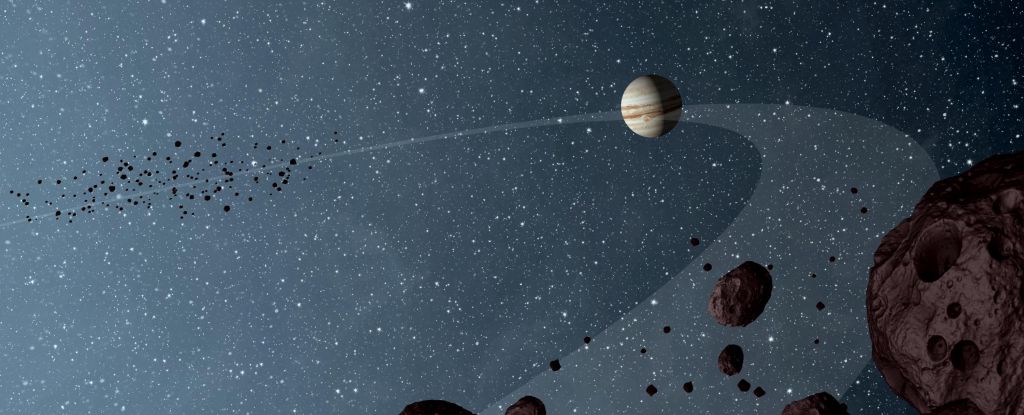Jupiter is not alone in its orbit around the sun. Two huge swarms of asteroids have become entangled in the gravitational interaction between the gas giant and our star, leading and following Jupiter as it transcends its cosmic scale.
Between these swarms, collectively known as Trojans, we identified ourselves more than 12,000 asteroids to date, but there is an odd conundrum baffling scientists: the leading swarm, known as the Greeks or L4 swarm, has significantly more asteroids than the trailing Trojans or L5, although both groups appear to be equally stable.
Now a team of scientists has an answer: a change in Jupiter’s distance from the Sun in the early days of the solar system. In particular, it is moving from closer to its current orbit.
“We propose that a rapid outward migration of Jupiter relative to the distance from the Sun may distort the configuration of the Trojan swarms, resulting in more stable orbits in the L4 swarm than in the L5 swarm.” says the astronomer Jian Li from Nanjing University in China.
“This mechanism that temporarily caused the two to take different evolutionary paths asteroid Groups sharing the orbit of Jupiter provides a new and natural explanation for the unbiased observation that the L4 asteroids are approximately 1.6 times the size of the asteroids in the L5 swarm.”
L4 and L5 refer to Lagrange points, gravitationally stable points that occur in two-body interactions. Every two-body system has five Lagrangian points where the gravitational interaction between the two bodies balances out centripetal force required for a small body to move with them.
Three of these points lie along the line connecting the two great bodies. The remaining two, L4 and L5, share the orbit of the smaller of the two bodies, L4 in front and L5 in the back.
frameborder=”0″ allow=”accelerometer; autoplay; write clipboard; encrypted media; gyroscope; picture in picture; web-share” allowfullscreen>
Jupiter’s Greeks and Trojans are likely to be similar in number, according to decades of research. The two populations have almost identical characteristics in terms of their stability and survivability, yet the Greeks are vastly superior to the Trojans. To find out why, Li and his colleagues decided to model Jupiter’s early evolution based on what is known as early giant planet instability.
This theory suggests that Jupiter formed in a different location than its current position, but was ejected by a gravitational perturbation of another planetary body early in the solar system’s history.
the Grand Tack Hypothesiswhich could solve several problems with the solar system, suggests that Jupiter moved inward towards the sun and then moved back to its current distance.
According to the team’s model, the asymmetry in the Trojan population can be replicated during a rapid outward migration in which Trojans are lost. Greeks, on the other hand, are lost in immigration. The team’s model suggests that Jupiter migrated outwards more than inwards, leading to a larger population of Greeks.
This is a different scenario from a 2019 study that found the asymmetry was the result from immigration alonebut it agrees better with the Grand Tack hypothesis.
The model, as it stands, is a pretty interesting starting point, but the researchers note that it’s relatively crude. Future research could work on creating a more detailed model to find out whether the number, order or length of migrations is relevant to the number of Trojans.
The current work also did not consider the possible effects of Saturn, Uranus or Neptune. For a more accurate result, these locations could be included.
And identifying more Trojans will provide a more accurate description of the population of these objects, which will also help refine future analyses, the researchers say. But the line of inquiry looks promising.
“The properties of the present solar system still hold unsolved mysteries in its formation and early development,” says the astronomer Nikolaos Georgakarakos from New York University Abu Dhabi in the United Arab Emirates.
“The ability to successfully simulate an event from an early stage in the evolution of the solar system and apply those results to modern questions may also be a key tool for astrophysicists and other researchers working to learn more about how our world began.”
The research was published in Astronomy & Astrophysics.





